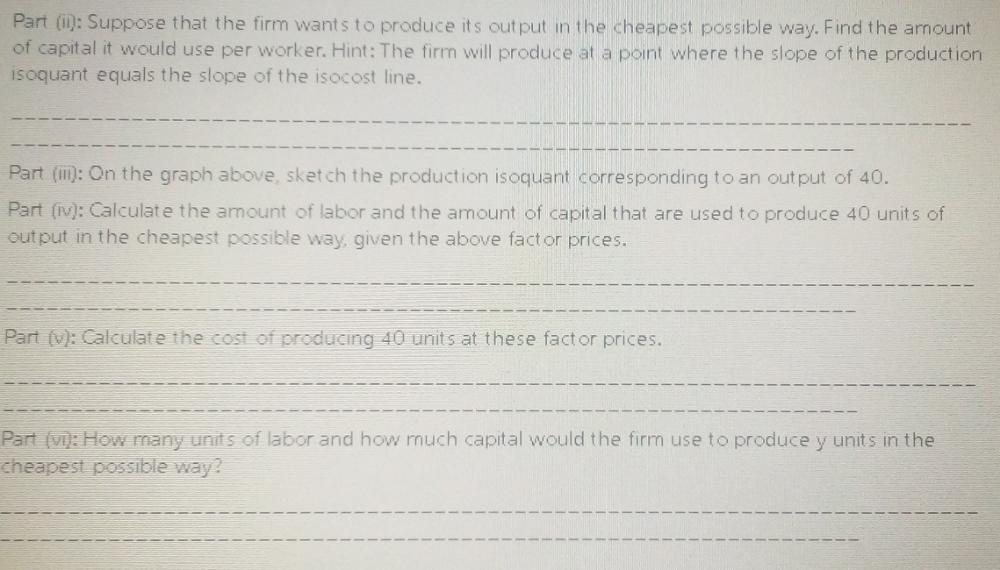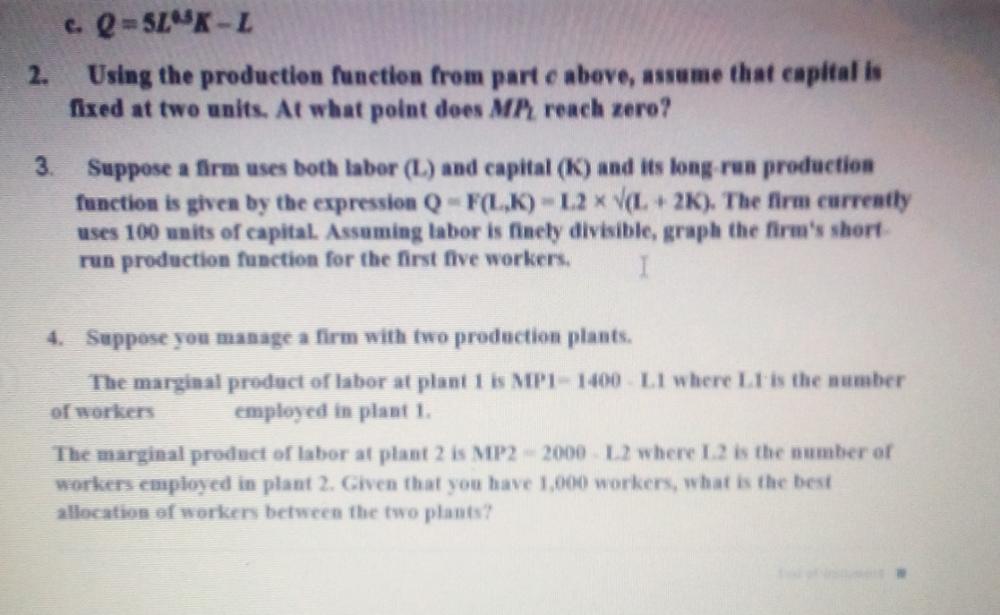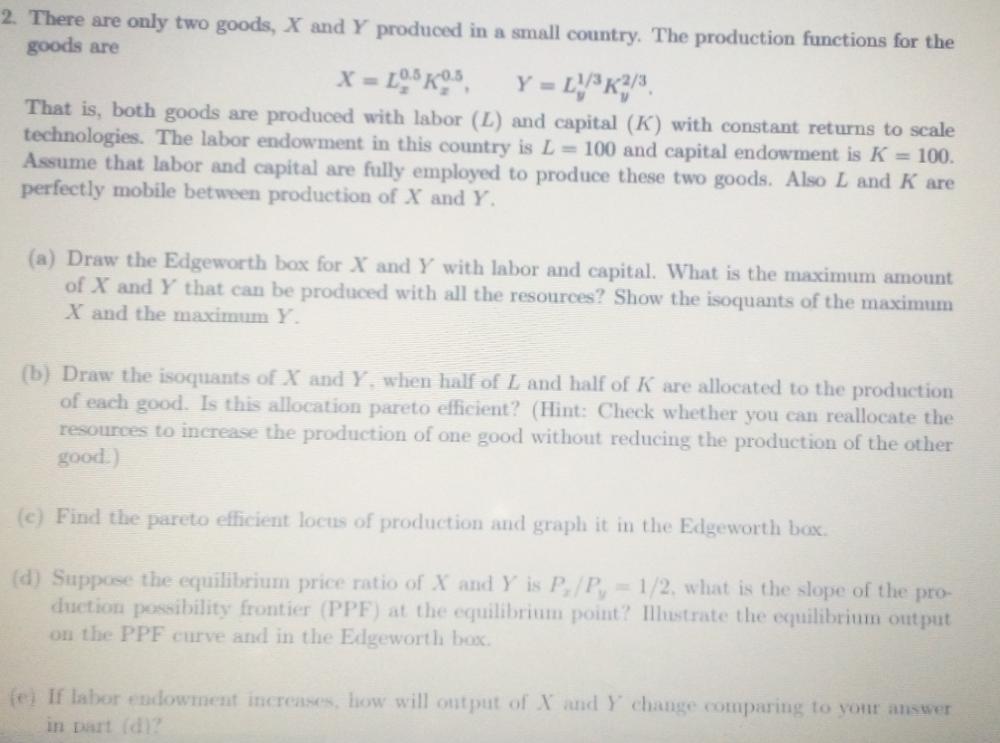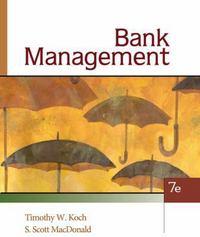




Kindly slove these questions clearly showing your workings
A firm uses labor and machines to produce output according to the production function: f(L,K) = 4L(1/2)K^(1/2), where L is the number of units of labor used and K is the amount of capital employed. The cost of labor is 540 per unit and the cost of employing capital is $10 per unit. Part (1): On the graph below, draw an isocost line for this firm that includes combinations of capital and labor that cost $400 and another isocost line showing combinations that cost $200. Place L on the horizontal axis and K on the vertical axis. Part (i): Suppose that the firm wants to produce its output in the cheapest possible way. Find the amount of capital it would use per worker. Hint: The firm will produce at a point where the slope of the production isoquant equals the slope of the isocost line. Part (ill): On the graph above, sketch the production isoquant corresponding to an output of 40. Part (iv): Calculate the amount of labor and the amount of capital that are used to produce 40 units of output in the cheapest possible way, given the above factor prices. Part (v): Calculate the cost of producing 40 units at these factor prices. Part (vi): How many units of labor and how much capital would the firm use to produce y units in the cheapest possible way?Part (il): Suppose that the firm wants to produce it's output in the cheapest possible way. Find the amount of capital it would use per worker. Hint: The firm will produce at a point where the slope of the production isoquant equals the slope of the isocost line. Part (ill): On the graph above, sketch the production isoquant corresponding to an output of 40. Part (iv): Calculate the amount of labor and the amount of capital that are used to produce 40 units of output in the cheapest possible way, given the above factor prices. Part (v): Calculate the cost of producing 40 units at these factor prices. Part (vij: How many units of labor and how much capital would the firm use to produce y units in the cheapest possible way?A firm produces computers with two inputs: Labor (L) and Capital (K). Its production function is y = Suppose the input prices are wy = 10 and wx = 100. (a) Graph the isoquants for y equal to 1 and 3. Does this technology show increasing, constant and decreasing returns to scale? WHY? (b) Derive the conditional factors demand? (c) Derive the Long-run Cost function, C(u). (d) If the firm wants to produce one computer, how many units of labor and capital should it use? How much will it cost? What if the firm wants to produce two computers?" (e) Derive the firm's long run average cost function AC(y), and long-run marginal cost function MC(y) Graph AC[y) and MC(). What is the firm's Long-run Supply curve?c. Q=51"K - L 2. Using the production function from part c above, assume that capital is fixed at two units. At what point does MP reach zero? 3. Suppose a firm uses both labor (L) and capital (K) and its long run production function is given by the expression Q - F(L,K) - 12 X V(L + 2K). The firm currently uses 100 units of capital. Assuming labor is finely divisible, graph the firm's short run production function for the first five workers. 4. Suppose you manage a firm with two production plants. The marginal product of labor at plant 1 is MPI- 1400 - LI where LI is the number of workers employed in plant 1. The marginal product of labor at plant 2 is MP2 - 2000 -L.2 where L.2 is the number of workers employed in plant 2. Given that you have 1,000 workers, what is the best allocation of workers between the two plants?2. There are only two goods, X and Y produced in a small country. The production functions for the goods are X = 105 K, . (0.5, Y = Ly/3 K213. That is, both goods are produced with labor (L) and capital (K) with constant returns to scale technologies. The labor endowment in this country is L = 100 and capital endowment is K = 100. Assume that labor and capital are fully employed to produce these two goods. Also L and K are perfectly mobile between production of X and Y. (a) Draw the Edgeworth box for X and Y with labor and capital. What is the maximum amount of X and Y that can be produced with all the resources? Show the isoquants of the maximum X and the maximum Y. (b) Draw the isoquants of X and Y, when half of L and half of K are allocated to the production of each good. Is this allocation pareto efficient? (Hint: Check whether you can reallocate the resources to increase the production of one good without reducing the production of the other good) (e) Find the pareto efficient locus of production and graph it in the Edgeworth box. (d) Suppose the equilibrium price ratio of X and Y is P. /P. = 1/2, what is the slope of the pro- duction possibility frontier (PPF) at the equilibrium point? Illustrate the equilibrium output on the PPF curve and in the Edgeworth box. (el If labor endowment increases, how will output of X and Y change comparing to your answer in part (d)
















